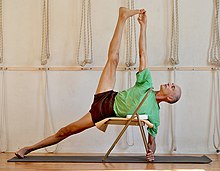Yoga brick
Lydia Willgress, writing in The Independent, states that the key considerations are the hardness of the material, which influences the comfort and support they provide; size and weight; and appearance.These considerations led to the development of yoga bricks in other materials, and to the marketing of hollow wooden blocks, which are lighter but more costly and less durable.[5][1] Manufacturers such as Manduka make recycled foam blocks, offering the combination of a light and strong prop with a low ecological impact.[10] Yin Yoga (founded c. 1975) uses props such as blocks to help get sensation into whichever area is of concern; the purpose may be to increase stress in an area, to reduce stress where it is not wanted, to make some poses accessible to the practitioner, to provide enough support to allow the muscles to let go, and to make poses more comfortable, permitting them to be held for longer.[11] Restorative Yoga (founded c. 2007) uses blocks extensively, for example arranging them under a bolster to create a ramp or to raise a part of the body.



Trikonasanaused as a propyoga as exerciseB. K. S. IyengarIyengar YogaRestorative YogaYin YogaasanasThe IndependentLululemontherapeutic use of yogahardwoodssoftwoodsEVA foamcuboidalYoga using propsuse of propsyoga matsVasisthasanaPaschimottanasanaEka Pāda RājakapotāsanaBaddha KonasanaEka Hasta BhujasanaAstavakrasanaUrdhva DhanurasanaSarah PowersYoga matYoga pantsJain, Andrea R.Business InsiderClark, BernieList of asanasStanding asanasDownward dogLotus positionMeditation seatsSun SalutationTree poseWarriorDrishtiNamastePranayamaVinyāsaHasta VinyasasTeacher trainingBritish Wheel of YogaEuropean Union of YogaAndré Van LysebethYoga AllianceTherapyAccessible yogaTrauma-sensitive yogaYoga nidraInternational Association of Yoga Therapists • Richard MillerJanice GatesCompetitive yogaInternational Day of YogaAsana JournalYoga JournalAngela FarmerHugger MuggerEarly modern yogaVivekanandaRaja YogaPierre BernardHarmonial gymnastics/yogaMarguerite AgnielMary Bagot StackGenevieve StebbinsPhysical cultureB. C. GhoshK. V. IyerSeetharaman SundaramParamahansa YoganandaAutobiography of a YogiHot yogaScience of yogaSexual abuse by yoga gurusMatthew RemskiYoga and cultural appropriationIn advertisingFor childrenFor womenGeeta IyengarYoga tourismHybridsNaked yogaMindful YogaFrank Jude BoccioAnne CushmanJon Kabat-ZinnCyndi LeePhillip MoffittAcroyogaPaddleboard YogaAerial yogaBeer yogaAmericaYoga for HealthLilias, Yoga and YouBritainLyn MarshallFranceGermanyRussiaSwedenRachel BrathenSelvarajan YesudianYoga Tradition of the Mysore PalaceYoga in Modern IndiaA History of Modern YogaPositioning YogaYoga BodyThe Subtle BodySelling YogaThe Path of Modern YogaRoots of YogaThe Story of YogaEnlighten Up!Breath of the GodsSchoolsThe Yoga InstituteShri YogendraHansa YogendraKaivalyadhamaSwami Kuvalayananda